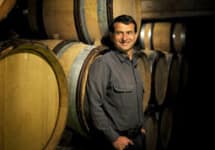Jean-Louis Chave Saint-Joseph 2010
-
Wine
Spectator -
Robert
Parker


Product Details
Your Rating
Somm Note
Winemaker Notes
Professional Ratings
-
Wine Spectator
Very solid, with the dark briary grip of the vintage carrying layers of fig, blackberry and plum fruit. An iron hint lurks in the background while the finish gets lift from bay and roasted alder notes. Best from 2015 through 2025.
-
Robert Parker's Wine Advocate
The stunning 2010 St.-Joseph ranks alongside the finest wines of the appellation, including Guigal’s l’Hospice and Chapoutier’s Les Granits. It boasts a dense purple color along with scents of kirsch, blackberries, crushed rocks, spring flowers and licorice. It needs 2-3 years of bottle age and should drink well for 15+ years thereafter.
Other Vintages
2020-
Robert
Parker -
Wine
Spectator - Decanter
-
Robert
Parker - Decanter
-
Jeb
Dunnuck
-
Wine
Spectator -
Jeb
Dunnuck -
Robert
Parker
- Decanter
-
Wine
Spectator -
James
Suckling -
Jeb
Dunnuck -
Robert
Parker
-
James
Suckling -
Wine
Spectator -
Robert
Parker -
Jeb
Dunnuck
-
James
Suckling -
Wine
Spectator -
Jeb
Dunnuck -
Robert
Parker
-
Wine
Spectator -
Robert
Parker
-
Wine
Spectator
-
Wine
Spectator -
Robert
Parker
-
Wine
Spectator -
Robert
Parker


Going back to 1481, when the first Jean-Louis Chave was gifted a vineyard in St Joseph by the nobleman Farconnet, 25 generations have farmed some of the best parcels in the Northern Rhône. Though now known as perhaps the best producer of Hermitage (and certainly among the best blenders in the world), the family only expanded to this famous hill during the mid-1800s wave of phylloxera that decimated Europe's vineyards.
In the 1970s, when Gerard Chave took over from his father, the domaine rapidly achieved megastar status due to the extraordinary quality of his wines. Gerard's son Jean-Louis (25th of his name) now oversees the estate and has shown an ever expanding dedication to improving the already stunning quality of these rare wines. Jean-Louis Chave regularly dedicates the domaine to intense and exacting projects, the benefits of which will be seen by future generations. Indeed, the estate employs three full time stonemasons just to repair the traditional stone walls dotting the vineyards.
Since the 1990s, Jean-Louis Chave has offered a second label known as 'J.L. Chave Sélection' that provides a glimpse of the reason for the estate's fame at a fraction of the price. Many of these wines are from declassified estate wine and long term farming contracts, and are vinified in the domaine's primary cellar in Mauves.

Marked by an unmistakable deep purple hue and savory aromatics, Syrah makes an intense, powerful and often age-worthy red. Native to the Northern Rhône, Syrah achieves its maximum potential in the steep village of Hermitage and plays an important component in the Red Rhône Blends of the south, adding color and structure to Grenache and Mourvèdre. Syrah is the most widely planted grape of Australia and is important in California and Washington. Sommelier Secret—Such a synergy these three create together, the Grenache, Syrah, Mourvedre trio often takes on the shorthand term, “GSM.”

A long and narrow valley producing flavorful red, white, and rosé wines, the Rhône is bisected by the river of the same name and split into two distinct sub-regions—north and south. While a handful of grape varieties span the entire length of the Rhône valley, there are significant differences between the two zones in climate and geography as well as the style and quantity of Rhône wines produced. The Northern Rhône, with its continental climate and steep hillside vineyards, is responsible for a mere 5% or less of the greater region’s total output. The Southern Rhône has a much more Mediterranean climate, the aggressive, chilly Mistral wind and plentiful fragrant wild herbs known collectively as ‘garrigue.’
In the Northern Rhône, the only permitted red variety is Syrah, which in the appellations of St.-Joseph, Crozes-Hermitage, Hermitage, Cornas and Côte-Rôtie, it produces velvety black-fruit driven, savory, peppery red wines often with telltale notes of olive, game and smoke. Full-bodied, perfumed whites are made from Viognier in Condrieu and Château-Grillet, while elsewhere only Marsanne and Roussanne are used, with the former providing body and texture and the latter lending nervy acidity. The wines of the Southern Rhône are typically blends, with the reds often based on Grenache and balanced by Syrah, Mourvèdre, and an assortment of other varieties. All three northern white varieties are used here, as well as Grenache Blanc, Clairette, Bourbelenc and more. The best known sub-regions of the Southern Rhône are the reliable, wallet-friendly Côtes du Rhône and the esteemed Châteauneuf-du-Pape. Others include Gigondas, Vacqueyras and the rosé-only appellation Tavel.
